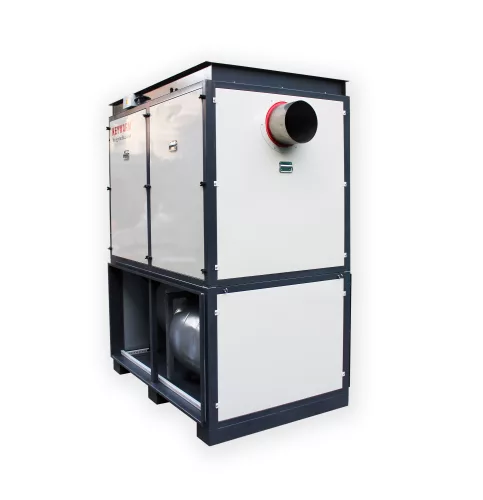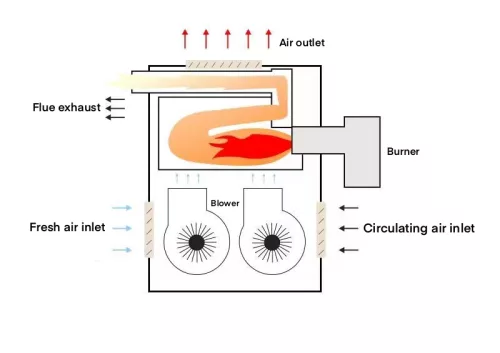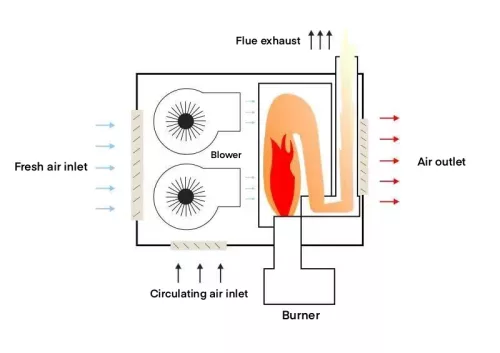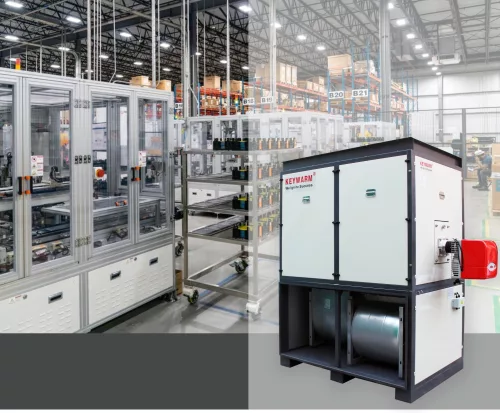APPLICATIONS
Industrial & Commercial Heating Uses
- Factories
- Warehouses
- Airports
- Railway Stations
- Supermarkets
- Offices,
- Gymnasiums
- Schools
- Exhibition halls
- Drying process such as food and painting.
Agricultural Heating Uses
- Greenhouses
- Poultry houses
ADVANTAGES
- Can disperse or direct heating.
- Integrated design for easy installation.
- Fully automatic operation, no need for personnel on duty.
- Wide power range, from 100kW to 1400kW.
- No need for complex water systems, low equipment failure rate.
- Quickly addresses heating issues in large spaces, warehouses, etc.
- Broad fuel adaptability, suitable for gas, oil, and other fuels.
HOW IT WORKS
A warm air generator is a stand-alone appliance serving to heat a given space and capable of operating on propane, natural gas or diesel.
Drum-type indirect-fired air heaters mainly consist of a combustion unit, a heat exchange unit, a fan unit, a filtration unit, and a control system. They can be installed indoors or outdoors (with the option to install a mixed adjustment device for fresh air and indoor return air). Equipped with a built-in centrifugal fan, the system delivers heated air to the desired area through the air supply system, achieving the purpose of heating.




Vertical Configuaration Horizontal Configuration
- Available in vertical or horizontal configurations, suitable for indoor or outdoor installation.
- Combustion is proportionally controlled, with a thermal efficiency exceeding 90%, resulting in energy savings.
- Multiple interlocking protection measures, including flameout protection, air pressure protection, overheat protection, and low gas pressure protection.
- Large combustion chamber design, small combustion chamber volume, low NOx emissions.
- Unique heat exchange tube design, increasing smoke disturbance, and achieving high heat exchange efficiency.
Here are the criteria to consider in selecting the units:
- Vertical or horizontal units;
- Indoor or outdoor applications
- Fuel types, such as natural gas, propane, diesel and etc.
- Max. static pressure of centrifugal blower(s)
- Heating power
- Air flow rate
To start with the installation, it’s best to begin with a pre-installation checklist (a list of items to check before installation). The following is a basic checklist, intended as an example:
- Choose a suitable location for installing the heater.
- Ensure that ventilation requirements can be met.
- Examine any issues that may affect the installation of HVAC, plumbing, and electrical systems.
- Design and plan the correct fuel supply pipeline.
- Design and plan the correct supply and return air ducts (if necessary).
- Check the minimum distance from combustible materials in accordance with manufacturer recommendations and local regulations.
- Ensure equipment is easily accessible for maintenance.

